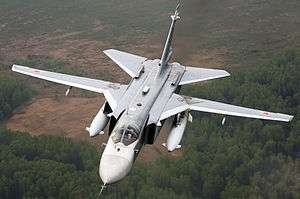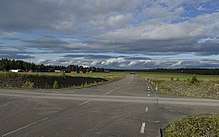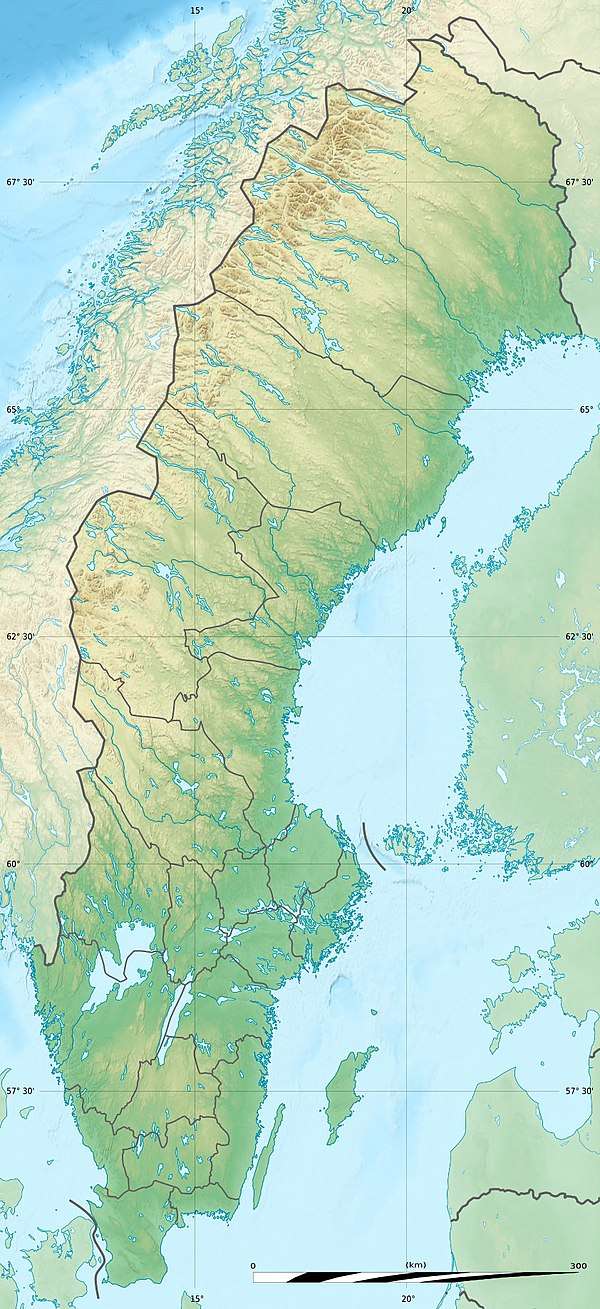Bas 90


Bas 90 (Flygbassystem 90, Air Base System 90) was an air base system used by the Swedish Air Force during the Cold War. Bas 90 was developed during the 1970s and 1980s from the existing Bas 60 system in response to the new threats and needs that had arisen since the conception of the Bas 60 system during the 1950s. Just like Bas 60 the Bas 90 system was based around defensive force dispersal of aircraft across many krigsbaser (wartime air bases) in case of war, as well as dispersion of the air base functions within the individual bases themselves. The air units would have been dispersed so one squadron (8-12 aircraft) would be stationed per krigsbas. The system was a protective measure against nuclear weapons and airstrikes, the purpose being to make it complicated for an opponent to destroy the Swedish Air Force on the ground and thus ensure endurance for the air force in a conflict scenario.
The Six-Day War, where the Israeli Air Force destroyed most of the Egyptian Air Force on the ground during its opening stages in Operation Focus, served both as validation for the Swedish dispersion concept and as reason to develop the system further. Another reason to improve the system was the introduction of long range attack aircraft (primarily the Su-24) and cluster munitions and anti-runway bombs, which made air bases more vulnerable to conventional bombing. Bas 60 had primarily been designed around the threat of nuclear weapons.
The development of Bas 90 began in the 1970s and started being implemented in the 1980s. The main improvements in Bas 90 compared to Bas 60 was the addition of backup runways in direct vicinity to the main airfield, a more mobile groundcrew and improved communication technology.
The goal was to have a total of about 200 runways of different types available for military use across Sweden. This included bases that would not be upgraded to Bas 90 standard, road runways from the Bas 60 system and selected civilian airports. The air bases became organized into flygbasgrupper (air base groups). One air base group consisted of a main base (built or planned to be built to Bas 90 standard) and a number of alternative and reserve bases.
Base layout
Bas 90 bases were mainly built from existing Bas 60 bases. The new system required expanding base infrastructure and construction of new fortifications. The new layout meant that the effective size of a base became 20-40 square kilometers, including surrounding terrain that needed to be surveillanced and defended.
Main runway
The main runway was the same as in the Bas 60 system and remained unchanged. It was a typical runway at a length of 2000–2300 m and 30–40 m wide, with a taxiway running parallel to it.
The main runway was designated Helge (H) in accordance with the swedish phonetic alphabet, with Helge standing for Huvudbana (Main runway).

|
Main runway (H) and short runways (B, C and D)
Public road
Flight line positions
KC, Command Centre
BasC, The Base Central
|
Kortbanor - Short runways
In order to avoid having aircraft becoming stuck on the ground or unable to land after an hostile airstrike on a base kortbanor ("short runways" or "short strips") were built as backup runways in the vicinity of the airfield. Typically 2-3 kortbanor were built per base. Similar to the road runways in the Bas 60 system these runways were often built on public roads. A kortbana differed in dimensions from a Bas 60 road runway though; a kortbana was 800 m in length and 17 m in width, compared to the older road runways which were 1500–2000 m in length and 12 m in width. Using shorter runways was made possible by the STOL capability of the Viggen (and later the Gripen). Also unlike the Bas 60 road runways the new short runways were built in direct vicinity to the main airfield and directly connected to the main airfield and each other via taxiways, which often also were sections of public road integrated into the base infrastructure. This meant that a Bas 90 base had several kilometers of taxiways in total. Usage of the short runways was limited in adverse light and weather conditions and would primarily be used if the main runway was not available.
The short runways were designated Bertil (B), Cesar (C), David (D), and so on in accordance with the swedish phonetic alphabet. The designations were assigned from north to south.
Flight line positions
Compared to Bas 60, the flight line positions in a Bas 90 base were dispersed even further. Individual aircraft positions were spread out along the taxiways across the entire area of the base. 20-40 individual flight line positions were built on a base, which was more than the number of aircraft that would be stationed there. This was to allow for moving around the flight line operations on a base over time. An aircraft landing on a base would be met by a motorcycle unit that then marshaled the aircraft to its flight line position, where the groundcrew would be waiting. The flight line positions could be concealed with camouflage nets and decoy aircraft were used to counter enemy aerial reconnaissance. Aircraft on stand-by at a flight line position would be connected to the bases communication net in order for the pilot to communicate directly with the base command and air defense central and also receive mission orders.
Operations

Kommandocentral - Command centre
The Kommandocentral (KC), command centre, from Bas 60 was kept, but expanded to be manned by 10 people instead of 6-8. The KC was located in an underground bunker and was from where the air traffic operations on the base were lead and organized.
Bascentralen (BasC) - The base central
A new addition in Bas 90 was Bascentralen (BasC), the base central, where the base command would be stationed. The BasC was located in an underground bunker. Pilots would also be stationed at the BasC in between missions. The BasC was equipped with computers for mission planning and the data could then be transferred to the aircraft computers.
TLF - The traffic leader at the field
Trafikledaren vid fältet (TLF), the traffic leader at the field, assisted in air traffic operations and could take them over completely if necessary. If someone was acting as TLF at one of the short runways they could also take over if required, carrying the necessary radio equipment in a vehicle.
Basbataljon 85 - Base battalion

A new type of base battalion was introduced with Bas 90; basbataljon 85 (base battalion type 85).
One of the main improvements with the new battalion type was a more mobile groundcrew that could perform mobile flight line operations. This meant that the groundcrew became motorized in order to quickly deploy to and between the bases many and spread out flight line positions, carrying the necessary aircraft munition, fuel, tools and other equipment in their vehicles and on trailers. This capability was called rörlig klargöring (mobile turnaround). The groundcrew units would have their staging areas spread out and located away from the base infrastructure as a safety measure, and then deploy from there as ordered. One group of groundcrew (klargöringstropp) consisted of 15 men, with 6 vehicles of different kinds and 4 trailers. A klargöringstropp was dimensioned and equipped to serve one aircraft.
Another addition was the newly formed Flygbasjägarna (Air Force Rangers), which were tasked with searching for and intercepting approaching attackers and infiltrators outside the bases normal defensive perimeters.
About 30 basbataljon 85 were organized during the 1980s. One battalion consisted of the following units:
- Bataljonstab (battalion command): command of the base and the battalion.
- Stabskompani (command company): air traffic control of aircraft on the ground and in the air.
- Stationskompani (station company): aircraft groundcrew and maintenance.
- Markförsvarskompani (ground defense company): base defense and surveillance, consisting of närskyddsplutoner (proximity defense platoons) and Flygbasjägare (Air Force Rangers). The närskyddsplutoner would form the defense around the immediate base area and the Flygbasjägare would patrol further away from the base.
- Skyddskompani (security company): base security, removal of unexploded ordnance and fire fighting.
- Flygfältsarbetskompani (field works company): base infrastructure repair and maintenance.
- Underhållskompani (service company): medical care, food service and logistics.
The defense of the base could also be reinforced with infantry and anti-air units from the Swedish Army.
Today
The Bas 90 project slowed down with the end of the cold war, and was halted by the mid 1990s. The system was completely scrapped in the 2000s and many of the wartime air bases have been demilitarized and sold to civilian owners. About 20 bases had been expanded to Bas 90 standard to varying degrees when the project was halted.
However, with the international developments during the 2010s, particularly in regards to Russia and the Russia-Ukraine conflict, there is renewed interest in reclaiming former air bases and their capabilities.[1][2]
List of Bas 90 air bases
Initially the Bas 90 project focused on expanding the air bases in northern Sweden, as the air force wanted to increase the base capacity in the region.

Karlsborg
Hasslösa
| Facility number | Airfield | Code 1 | Code 2 | Year(s) built | No. of short runways | Other |
|---|---|---|---|---|---|---|
| Anl 102 | Gunnarn | fält 28 | 60 | 1987 | 3 | |
| Anl 103 | Hagshult | C 18 | 29 | 1983 | 3 | Still in use. |
| Anl 105 | Moholm | fält 8 | 36 | – | – | Planned, not expanded. |
| Anl 106 | Hallviken | fält 27 | – | – | – | Planned, not expanded. Older airfield built during World War II. |
| Anl 109 | Tierp | fält 14 | 48 | – | – | Planned, not expanded. |
| Anl 113 | Heden | fält 32 | 61 | – | – | Planned, not expanded. |
| Anl 115 | Råda | fält 20 | 37 | 1990-1991 | 4 (shared with Såtenäs) | Formed a pair base together with Såtenäs. |
| Anl 119 | Fällfors | fält 40 | 66 | 1983 | 3 | The only Bas 90 base with a mountain hangar. |
| Anl 120 | Örebro | – | 47 | 1994 | 0 | Partially expanded, no short runways. Civilian airport. |
| Anl 126 | Hasslösa | fält 6 | 35 | – | – | Planned, not expanded. Would have formed a pair base together with Lidköping. |
| Anl 130 | Uråsa | fält 88 | 27 | – | – | Planned, not expanded. |
| Anl 131 | Lidköping | fält 21 | 34 | – | – | Planned, not expanded. Would have formed a pair base together with Hasslösa. |
| Anl 136 | Rommehed | fält 15 | 44 | 1990 | 2 | |
| Anl 143 | Kjula | fält 56 | 46 | 1987 | 2 | |
| Anl 147 | Visby | C 25 | 43 | 1992 | 1 | |
| Anl 150 | Optand | fält 26 | – | 1991 | 2 | No main runway, only two short runways. |
| Anl 160 | Vidsel | fält 42 | 62 | 1989 | 3 | Today Vidsel Test Range. |
| Anl 163 | Sättna | fält 45 | 58 | – | – | Planned, not expanded. |
| Anl 166 | Kosta | fält 87 | 31 | – | – | Planned, not expanded. |
| Anl 168 | Gällivare | fält 33 | – | – | – | Planned, not expanded. Civilian airport. |
| Anl 170 | Kubbe | fält 44 | 57 | 1990 | 3 | |
| Anl 171 | Åmsele | fält 41 | 67 | 1985 | 3 | |
| Anl 172 | Knislinge | fält 84 | 25 | – | – | Planned, not expanded. |
| Anl 177 | Byholma | fält 85 | 26 | 1989 | 2 | |
| Anl 181 | Färila | fält 46 | 59 | 1991 | 3 | |
| Anl 189 | Jokkmokk | fält 49 | 69 | 1988 | 3 | Still in use. |
| Anl 192 | Mora | – | – | – | – | Planned, not expanded. Civilian airport. |
| Anl 202 | Arvidsjaur | – | – | 1989 | 0 | Partially expanded, no short runways. |
| Anl 211 | Karlstad | – | 53 | 1997 | 0 | Partially expanded, no short runways. |
| Anl 301 | Hässlö | F 1 | 01 | 1991 | 1 | Partially expanded, one short runway. |
| Anl 303 | Malmen | F 3 | 03 | 1992 | 1 | Partially expanded, one short runway. Today houses the helicopter wing of the Swedish Air Force. |
| Anl 304 | Frösön | F 4 | 04 | 1991 | 1 | F 4 Frösön |
| Anl 305 | Ljungbyhed | F 5 | 05 | 1985 | 1 | F 5 Ljungbyhed. Partially expanded, one short runway. |
| Anl 306 | Karlsborg | F 6 | 06 | – | – | F 6 Karlsborg. Planned, not expanded. |
| Anl 307 | Såtenäs | F 7 | 07 | 1990-1991 | 4 (shared with Råda) | F 7 Såtenäs. Formed a pair base together with Råda. |
| Anl 313 | Bråvalla | F 13 | 13 | 1981 | 0 | F 13 Norrköping. Partially expanded, no short runways. |
| Anl 315 | Söderhamn | F 15 | 15 | 1978 | 1 | F 15 Söderhamn. Partially expanded, one short runway. |
| Anl 316 | Uppsala | F 16 | 16 | ? | 0 | F 16 Uppsala. Partially expanded, no short runways. |
| Anl 321 | Luleå | F 21 | 21 | 1996 | 1 | F 21 Luleå. Partially expanded, one short runway. |
References
- ↑ Andersson, Janne (2017-09-14). "Se när JAS Gripen landar – mitt på vägen: "Det är old school"". Skaraborgs Läns Tidning (in Swedish). Retrieved 2017-12-10.
- ↑ Jodenius, Per (2017-05-08). "Försvarsmakten intresserad av flygfält i länet - Smålandsposten". Smålandsposten (in Swedish). Retrieved 2017-12-10.
- Rystedt, Jörgen (2009). Flygbassystem 90 (pdf), Försvarets Historiska Telesamlingar.
- Törnell, Bernt (2007). Svenska militära flygbaser (pdf), Fortifikationsverket.
- Hofvander, Bo (1981). Bas 90, Flygvapnets nya bassytem (pdf). Flygvapnnytt.
- Hofvander, Bo (1981). Bas 90, Flygvapnets nya bassystem (del 2) (pdf). Flygvapnnytt.
- Hofvander, Bo (1994). En svensk profil (pdf). Flygvapennytt.
Bibliography
- Andersson, Lennart. Svenska Flygbaser. Svensk Flyghistorisk Förening (SFF), 2008. ISSN 0345-3413
- Andersson, Lennart. ÖB:s Klubba. Svenskt Militärhistoriskt Bibliotek (SMB), 2010. ISBN 9789185789740
- Andersson, Lennart, et al. Svenskt Flyg Under Kalla Kriget. Medströms Bokförlag, 2016. ISBN 9789173291347
External links
- Flygbassystem 90 (YouTube), Flygvapnets TV-studio. In Swedish, English subtitles.
.jpg)